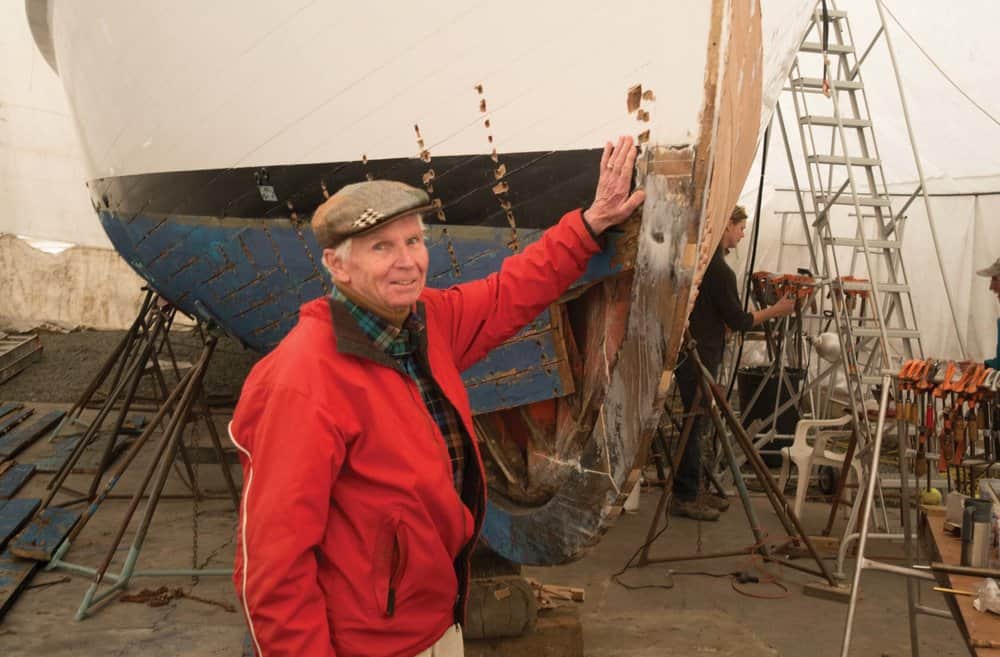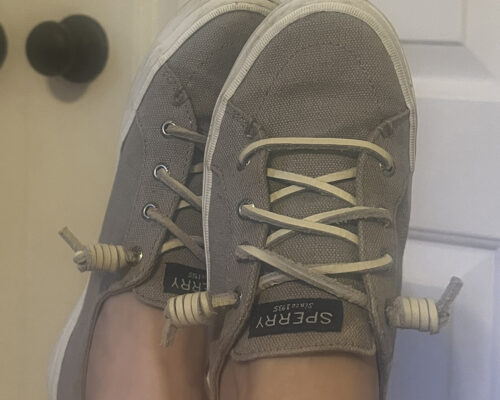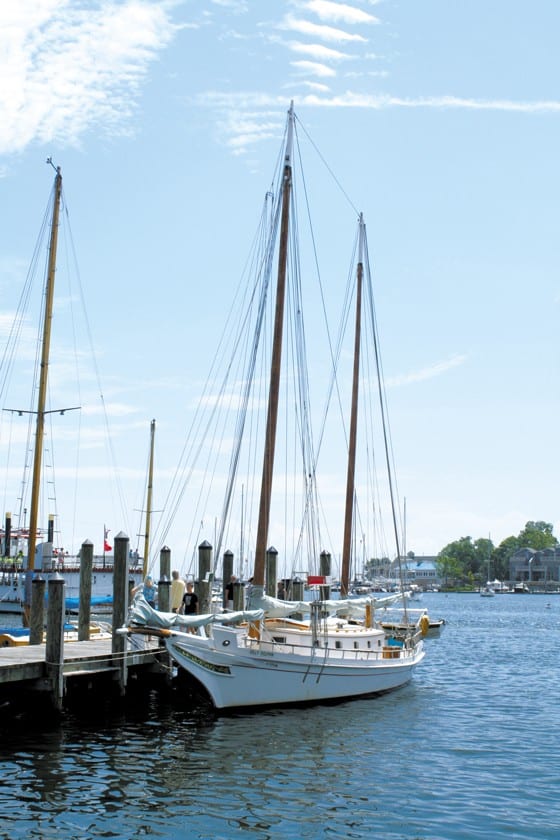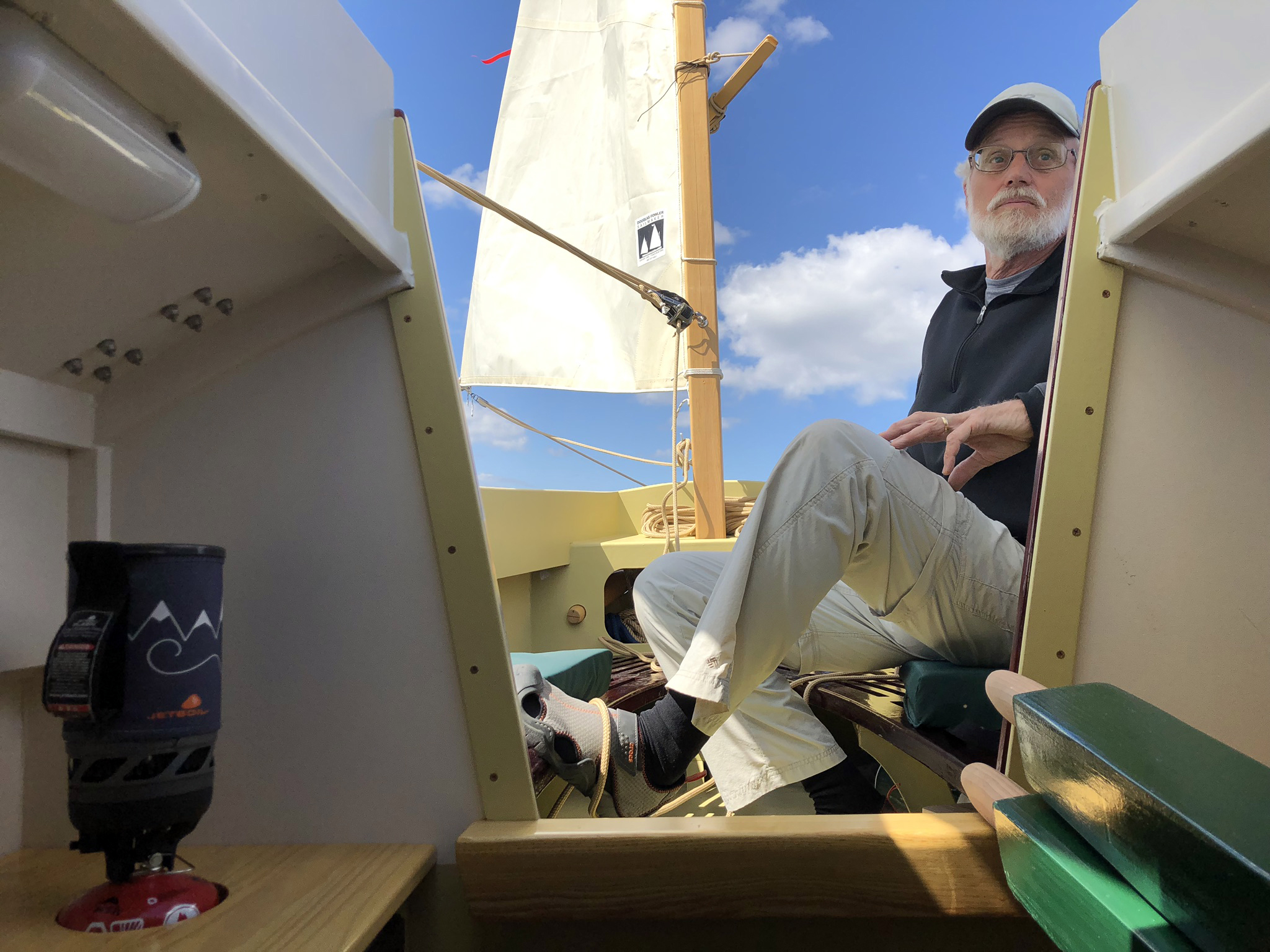By Wendy Mitman Clarke
Fred Hecklinger’s career bridges the distance between wooden working craft and world-class sailing yachts, and he remains a walking encyclopedia of traditional boats.
Photo by Joe Evans.Fred Hecklinger has a yardstick in his hand and is using it as a pointer as he guides a visitor through the half-models, drawings, artifacts and paintings that comprise what is really a minor maritime museum in his house in Annapolis, hard by the Chesapeake Bay. ¶ The tour starts on the ground floor and is marvelously narrated. Though an admittedly “frightfully poor student” in traditional education in 1940s Baltimore, the only school Hecklinger has ever truly cared about is that of yachting and sailing ships—with a particular focus in gaff-rigged schooners—and in that academy, he is a master teacher with a meticulous eye and endless enthusiasm for his subject. A voracious reader of all books, magazines and publications maritime since he was a boy, Hecklinger’s keen memory for detail seems nearly photographic. And like any teacher you’ve ever known who cares deeply for his discipline, no error or excellence slips past his observation. Accuracy is everything.
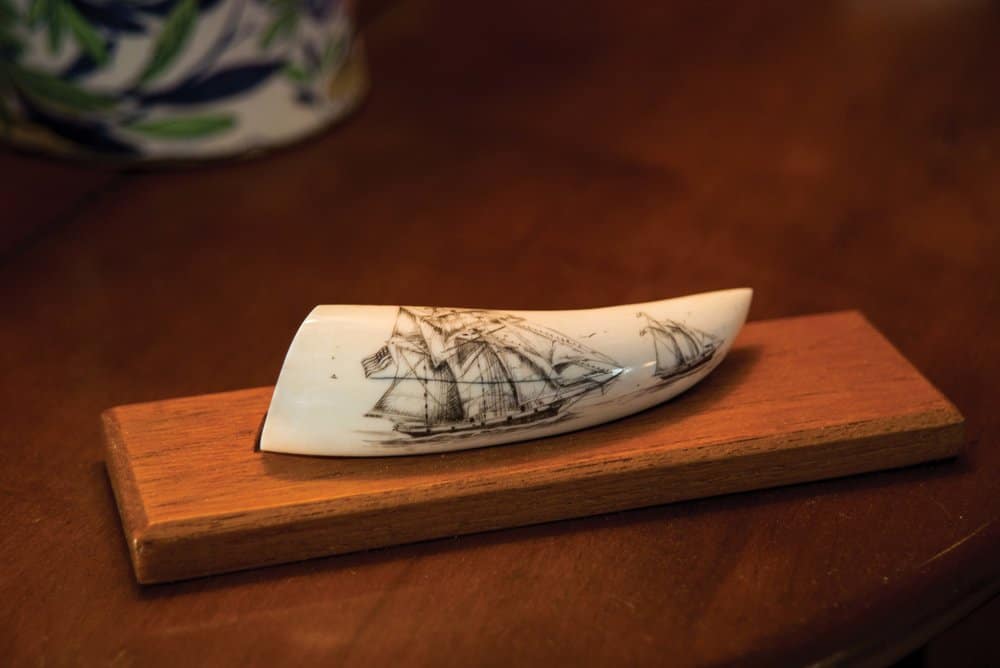
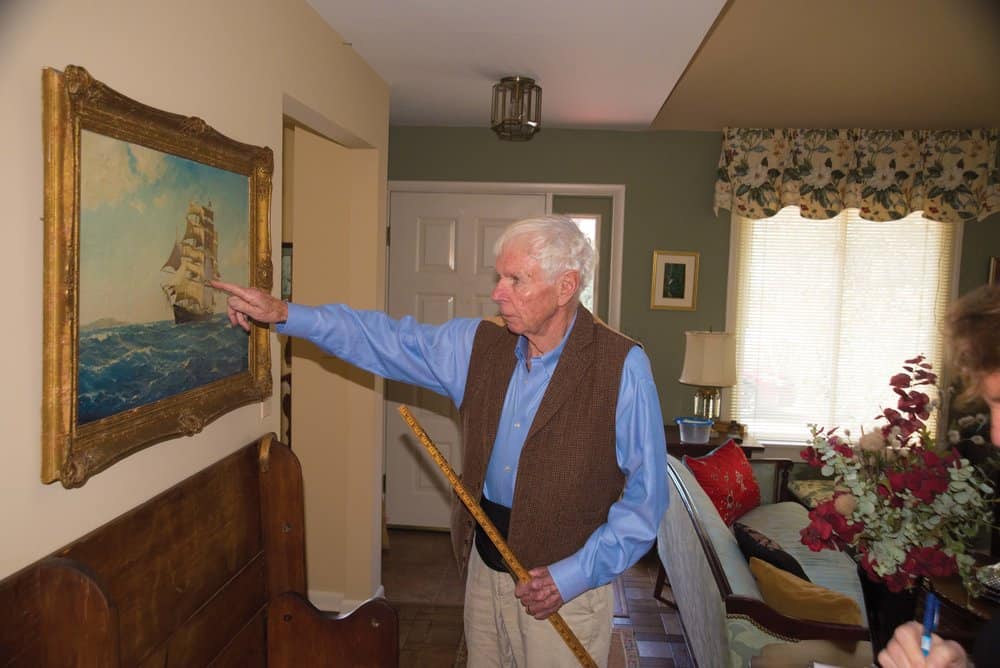
The yardstick points to the spidery black lines of scrimshaw on a whale tooth the size of a mango.
“This was carved by George Rich, he was a merchant seaman, an engineer, who had gotten into scrimshaw,” Hecklinger says. “It was a hobby of his. And I saw some of his scrimshaw, but he didn’t understand his rigging. I had bought that tooth bare in Nantucket for two dollars and fifty cents, I think, and I gave it to him and coached him as far as the rig was concerned and he engraved it.”
We move along, the names and bits of description carrying us forward: “This is Geneva May, the fist skipjack I sailed in. She was 52 feet . . . this is a bugeye; this is a piece of the America. I made over the years maybe 50 models like this of the America of wood from the America, and that was my walking-around money. This is what you call a New Haven sharpie. This is a Boston pilot boat; I forgot her name. This is a Bahama dinghy, I made this model. This one was from Man O’ War Cay. I call it a country model—it’s not very accurate.”
There’s the Californian, a topsail schooner, and the J/Boat Shamrock V, a model which he traded for one of his America models—“It was a good deal.”
“And here’s a builder’s half-model of a 47-foot Belizian sloop built by a fellow named Peter Young in Caye Caulker. You can see where he made pencil lines and then took calipers and took the lines off, made a table
of offsets.”
On to a line drawing of the 108-foot square topsail schooner Shenandoah, a painting of a three-masted coastal schooner of 1780 or so, a whaleboat from Indonesia, a pungy schooner drawn by Melbourne Smith, who along with Hecklinger, built the first Pride of Baltimore; and a fine painting of the Cutty Sark, which Hecklinger bought on Charles Street in Baltimore years ago. His assessment: “It’s fairly accurate, but it has a seaman going up the lee rigging. Now, no seaman would ever do that. You always go up the windward rigging. For one thing, it’s tighter, and it’s sloping the way you’re going. Somebody didn’t understand that. But it’s very accurate as far as the rigging goes.”
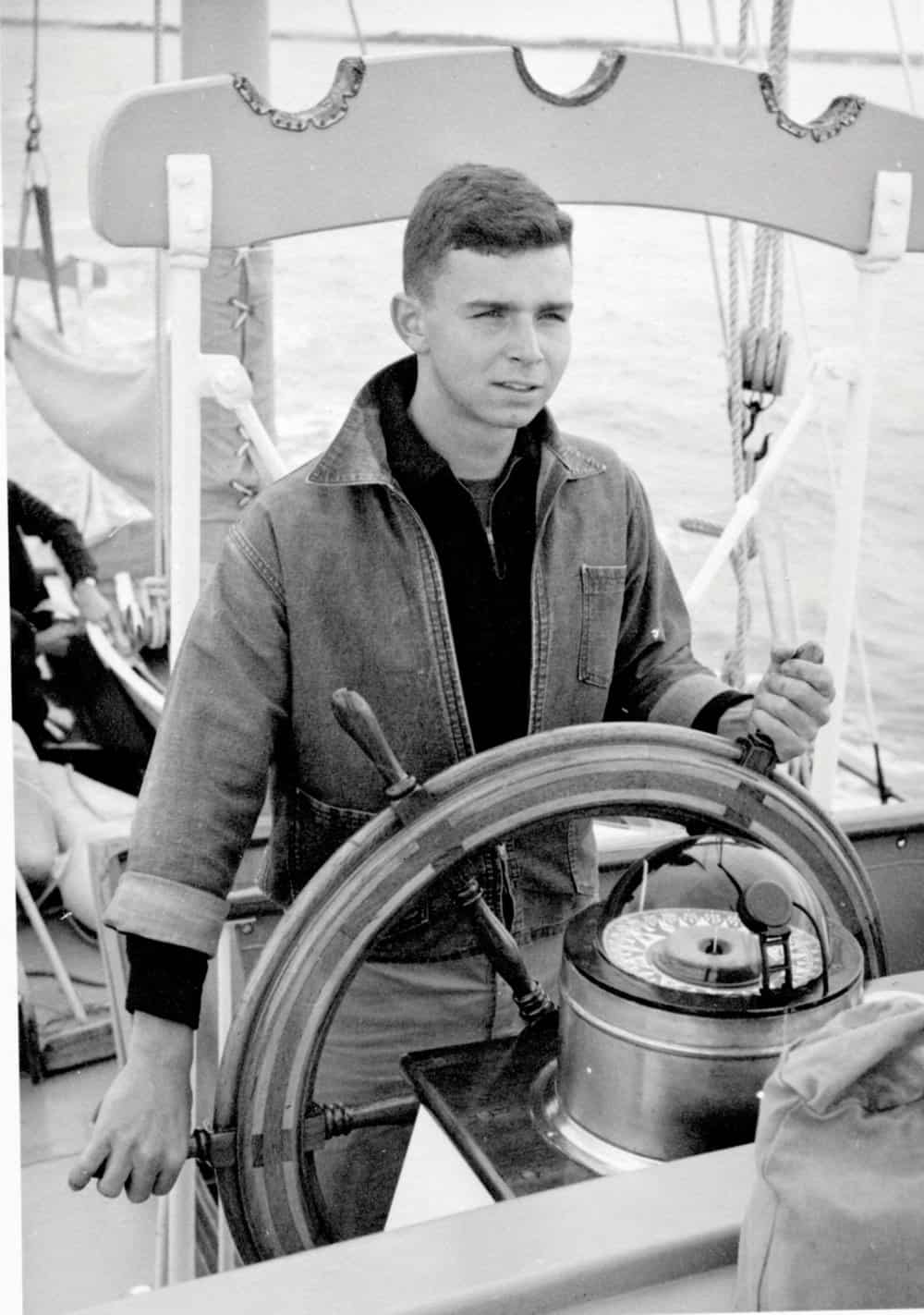
We’re upstairs now, have been for a while, and he stops at another painting he notes as one of his favorites. He bought it at an antiques show in Baltimore in the 1960s for $15. It’s hopelessly romantic of another era, a visual rendition of a John Masefield poem.
“This is a British merchant vessel of the latter 19th century. It’s wonderfully accurate,” Hecklinger says. “I believe he’s just dropped a tug there, they’re outward bound. They’ve dropped the tug and this is the pilot boat, so they’re heading off soundings for Australia or South Africa. I like this a lot.”
Eventually, our eyes fall to a photograph of a much younger version of Hecklinger, shirtless and shoeless on the deck of the Pride of Baltimore somewhere between St. Thomas and Key West. He’s laughing as he leans back to counter-balance the weight and length of the mahi-mahi he’s barely holding up, his arms doing a pull-up with the massive fish that is nearly as long as he is. If ever there were a photo of living the age-old dream, of a young man answering that ageless calling to the sea on sailing ships, this is it.
“I like to say that I have, since age 16, secured a living, however shaky at times, by messing about in boats,” he says. Of course, he is being accurate, if modest. Now 81 years old, Hecklinger has enjoyed a career that has touched the top echelons of yachting, ocean racing, traditional shipbuilding and sailing, and—once he finally settled down a little and married his beloved wife of 40 years, Bobbie—marine surveying. He is a walking encyclopedia of traditional boats and ships whose knowledge of the complexities and intricacies of sailing ship rigging is unsurpassed.
His story began in Baltimore, where “there was always an interest in nautical things in our house.” His grandfather was a skilled ship modeler, and his father, an amateur cabinet maker, had spent time in merchant vessels in the 1920s. At that time, he says, there were still some commercial sailing vessels on the Bay other than skipjacks, bugeyes and oyster boats. All this was at his doorstep, but it was books and magazines—especially Rudder—that fed his early fire.
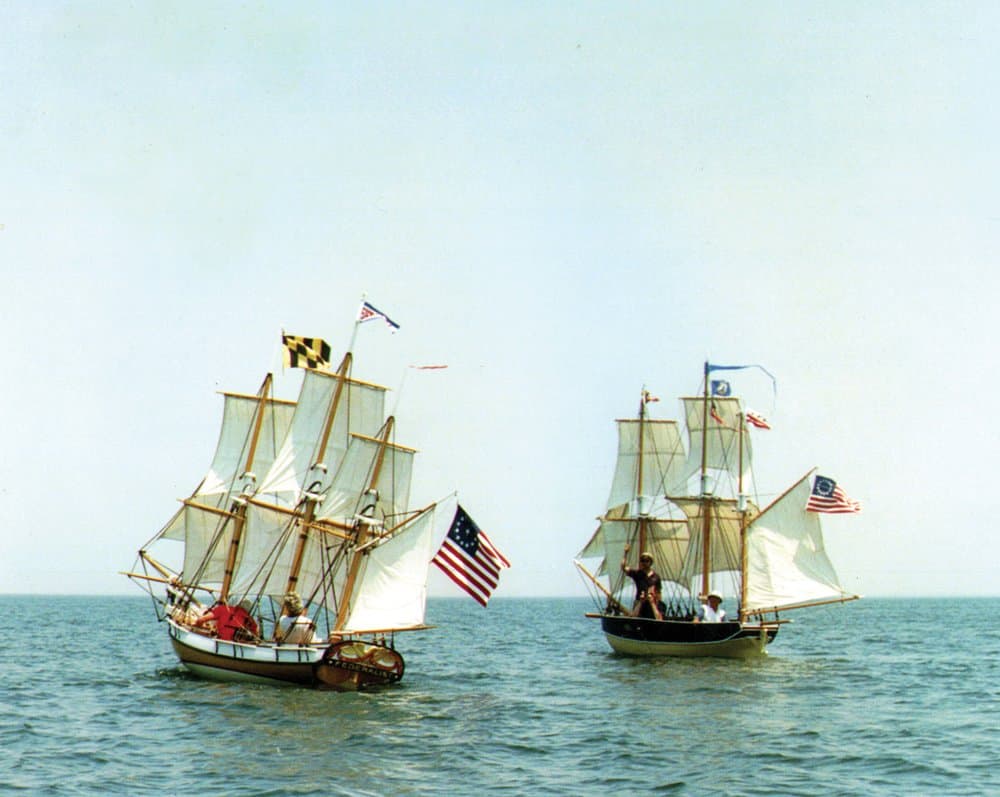
He met world traveler and renowned sailor Irving Johnson, and when author, adventurer and traditional ship sailor Alan Villiers came to town to give a talk, Hecklinger made sure to introduce himself. “We had a very nice discussion and he signed a book saying something clever like, ‘To Fred Hecklinger, for his unusual capacity for understanding what this book is about.’ I met him more than once and corresponded with him.”
By the time he was 11 he’d figured out that large yachts had paid crews, and since merchant shipping on sailing ships was all but over, and “I knew I wasn’t going to be an engineer or a mathematician, I was just a frightfully poor student,” he determined that this would be his path. By the time he was 15, he built a 15-foot lumberman’s bateau from a design he found in Boy’s Life magazine. He taught himself marlinspike seamanship, line splicing, and other basic skills he knew he’d need. At 16, he left school and home for Oxford, Md., in search of the large yachts he was looking for.
Some people believe that if you begin living toward your passion, the universe will open doors for you. In Hecklinger’s case, that open door was C. Sherman Hoyt, a world-renowned yachtsman whose chops included Harold Vanderbilt’s defense of the 1930 America’s Cup, as well as Vanderbilt’s J/Class boat, Rainbow, in the 1934 cup. In his late 70s, he was spending the summer of 1953 in Oxford sailing a lovely 49-foot daysailer, an 8-meter called Hurrying Angel, designed and built in 1925 by Fife in Scotland. Of course, Hecklinger knew Hoyt was a star in the firmament of yacht racing, and he didn’t hesitate to meet him.
“I said something clever like, ‘I’d like your advice on how to secure a position as a paid hand on a sailing yacht,’ ’’ Hecklinger says. “I don’t know that I told him much about my skills at that time, but he said, ‘I’m going to have the use of an 8 meter here in Oxford over the summer, and I’m going to need a paid hand.’ That was it.”
On Fridays, the two would leave Oxford and sail across the Bay to Annapolis or Gibson Island for whatever regatta was happening that weekend. They’d race around the buoys, then return to Oxford on Sunday or Monday, and Hecklinger would spend the week cleaning, varnishing, mending the well-used sails, and using shoulder-power to row the Camper & Nicholsons dinghy that served as tender to the engineless Angel.
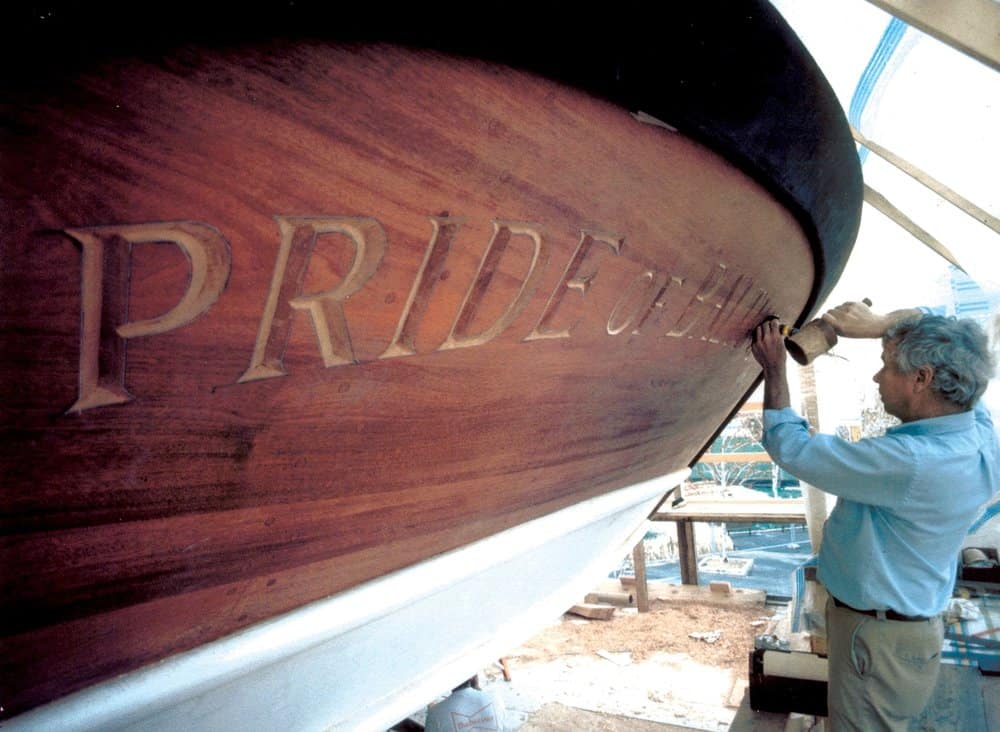
Hoyt was an ideal mentor, and the boat an ideal platform for Hecklinger to begin his career. The two remained friends and correspondents until Hoyt’s death in 1961. Framed in Hecklinger’s office is the letter of recommendation Hoyt wrote in a graceful hand dated October 30, 1953, under the letterhead of The Oxford Boatyard Co., which notes that the young Hecklinger is “always of a pleasing and cheerful personality” who “took pride in the proper maintenance of the boat with little supervision on my part, and in spite of rather inadequate galley facilities, proved a good cook.” Hecklinger, he wrote, is “Honest and sober, I am glad to recommend him most sincerely for any job on a sailing craft where, for one of his age, the all around knowledge of a highly paid professional yachting hand, acquired through many years, is not considered absolutely essential.”
So began a yachting career that would see Hecklinger either as master, mate, or crew on an enormous range of vessels, from a 59-foot William Hand-designed motor sailor and a 45-foot ocean racer owned by Henry B. du Pont, who at the time was commodore of the Cruising Club of America, to the 96-foot gaff schooner Caribee, designed by Howard Chapelle. When Hecklinger met her, Caribee was owned by Walter Boudreau, whose son, Peter, grew up aboard her. Peter Boudreau would later work with Hecklinger on the first Pride of Baltimore and go on to become the builder of the second Pride.
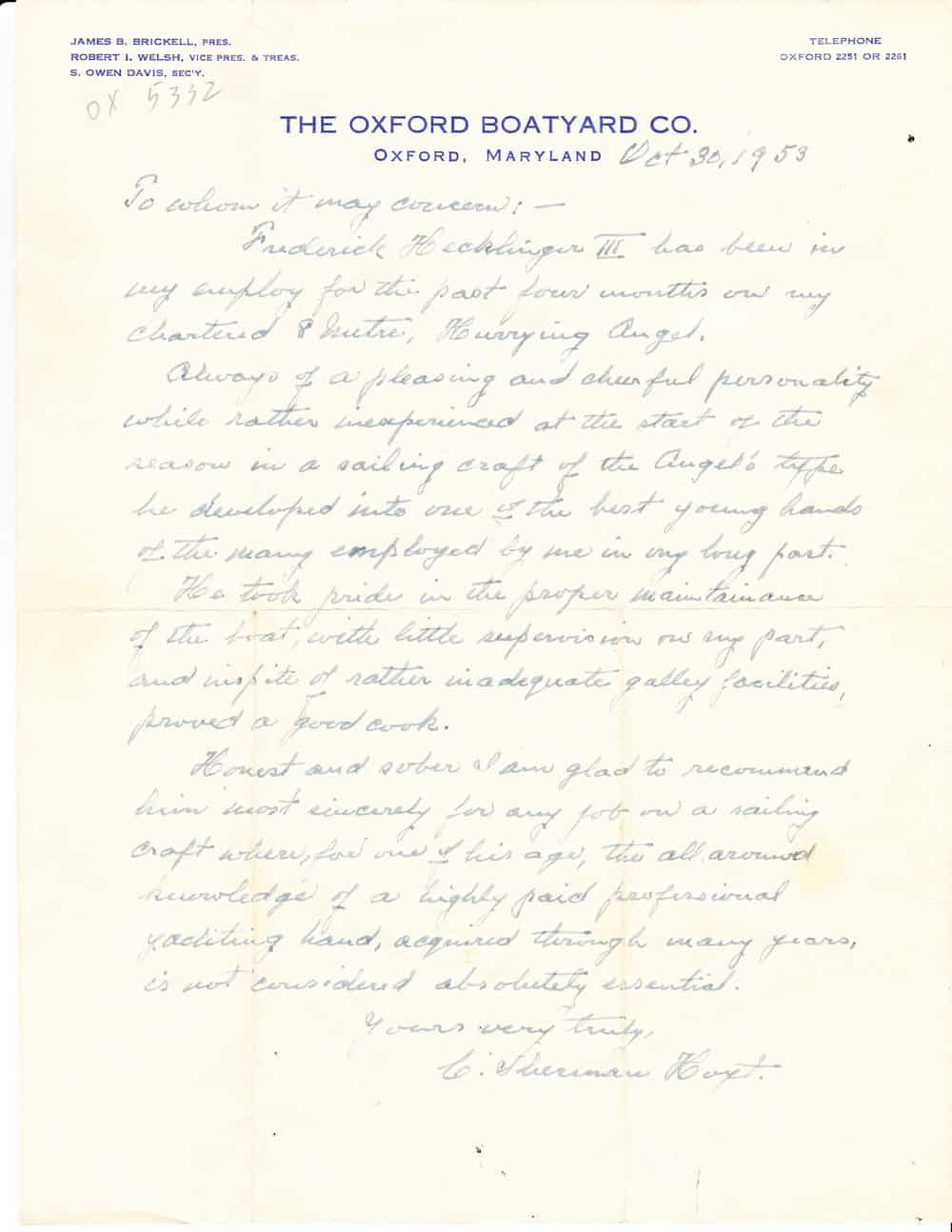
A regular in the Southern Ocean Racing Circuit, Hecklinger worked for well-known yacht owner Al Van Meter on his 51-foot Sparkman & Stephens, Bandit, and eventually the beautiful, 61-foot S&S, Running Tide. He sailed in Maine and the Caribbean for two years with the schooner America—a re-creation of the original America, whose wood he salvaged when she was destroyed in a shed collapse in Annapolis in 1942, and from which he made some of those models for his “walking-around money.”
Integral to the rigging design of the first Pride of Baltimore, he turned down a job as its captain because by then, he and Bobbie were happily married, he didn’t want to travel all the time, and his surveying business—through which he became nationally known as a surveyor of wooden vessels of all kinds—was taking off. “I actually went to 23 states to survey boats, including South Dakota,” he says.
Always admiring of the Bay’s traditional skipjacks, he helped start Chesapeake Appreciation Days in 1965, gathering the boats at Sandy Point State Park for races and a celebration of the last working fleet under sail in the country. And when Melbourne Smith designed the recreation of the Federalist, the miniature ship that Revolutionary naval hero Joshua Barney presented to George Washington at Mount Vernon in 1788, Hecklinger helped sail the 15-foot ship from Baltimore to Mount Vernon, more or less re-enacting Barney’s journey of 200 years earlier.
“I said to them, ‘For sailing it, you’re going to need someone who has square-sail experience and a knowledgeable small-boatman, and someone who has sailed on the Pride of Baltimore or some other re-creation,’ ” he says. “And they hemmed and hawed and said, ‘We’d like you do to it,’ and I said, ‘You can’t afford me!’ And they said, ‘For two weeks, we think we can.’ So I got a thousand dollars a week, which was the most money I’d ever made in a week!”
These days, Hecklinger says he’s working on a variety of small projects but nothing too big. He had a heart attack three years ago, and that told him it was time to pull in his surveying shingle. Getting old is hard, he acknowledges, but “It’s an event denied to many. I’ve been lucky all my life. It was a planned luck, and being at the right place at the right time.”
Lucky, perhaps, but also committed from the beginning to the grace and glory of the maritime past, and for the simple, enduring love of messing about in boats.

